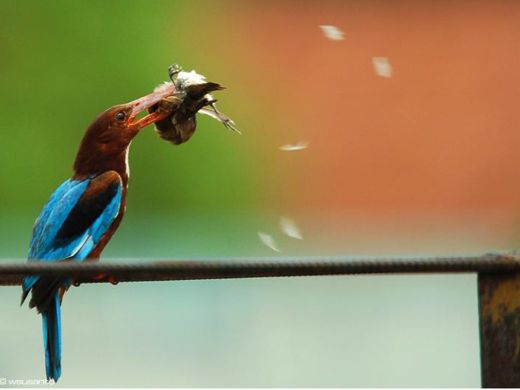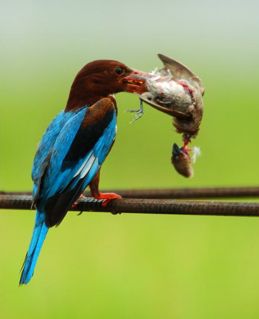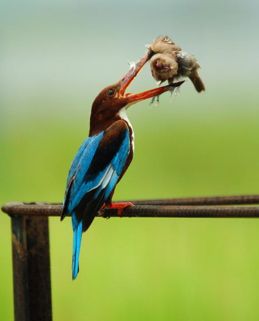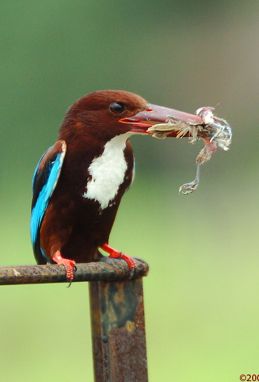Willis documented a White-throated Kingfisher (Halcyon smyrnensis) catching a Scaly-breasted Munia (Lonchura punctulata) at Wak Hassan Drive, opposite Sembawang Park. The documentation was done way back in April 2005 and only now made available to viewers.
“The kingfisher was perching on a nearby railing when it spied the munia. It immediately dived down into the grass and grabbed the helpless bird. The prey was brought back to the perch and whacked repeatedly against the metal railing, sending feathers flying all over (above). So severe was the thrashing that the head of the dead bird was nearly severed (below left). Even after the head was totally severed, the body of the munia was still a little too large for the kingfisher to swallow (below right).
“After a while the bird flew to a nearby perch (below left) where it was joined by its mate. The mate appeared aggressive and wanted a piece of the prey. It grabbed at the dead munia. There was a struggle and the mate ended with a piece of the thigh (below right).
“It seems that the kingfisher regularly hunts small birds. During my birding around the area, I’ve seen it caught munia twice, only that I did not have my camera with me then, so it wasn’t documented. So I think this particular White-throated Kingfisher has grown to love eating munias.
“There is a pair resident in the area. Their usual diet consists of insects and lizards, which are abundant in the area.”
Wells (1999) reports the White-throated Kingfisher taking White-rumped Shama (Copsychus malabaricus) chicks, Tree Sparrow (Passer montanus) and munias (Lonchura sp.).
Reference:
Wells, D.R. (1999). The birds of the Thai-Malay Peninsular. Vol. I, Non-passerines. Academic Press, London.
All images by Willis.
This post is a cooperative effort between www.naturepixels.org and BESG to bring the study of bird behaviour through photography to a wider audience.















6 Responses
A nice set of pictures, a good documentation of bird behavior!
Wow, that’s a tough cookie and really ambitious to want to swallow the munia whole.
Wow! This is great! I’ve never known that a kingfisher would eat other bird
Amazing,
I dont think that Kingfisher eat bird too. How a wonderfull foods chain.
THAT WAS REALLY VERY NICE.EXCELENT PHOTOES WITH NICE DESCRIPTION. I AM WORKING ON THIS BIRD NOW.SO IF U HAVE SOME MORE INFORMATION ABOUT THIS BIRD, ESPECIALLY ON BREEDING PLEASE SEND ME.
Did a search for “munia” on Google Images to show my friend what a munia was… and ended up here. I had no idea kingfishers ate anything other than fish. Very interesting post; thanks for documenting!